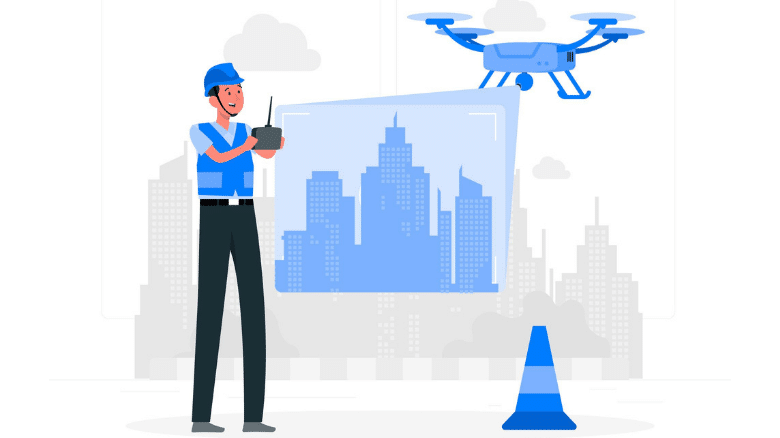Introduction:
Today, we delve into the intriguing world of drones and their invaluable contribution to the construction industry. With their versatility, efficiency, and precision, drones have revolutionized the way construction projects are planned, executed, and monitored. From surveying vast terrains with ease to providing real-time aerial footage, these aerial wonders have become an indispensable asset for improving efficiency, safety, and productivity on construction sites. Join us as we explore the exciting role that drones play in shaping the future of construction.
The construction industry, despite its monumental advancements, has often been criticized for its slow pace of technology adoption. However, the rise of drones in recent years has injected a much-needed dose of innovation, revolutionizing how we approach planning, building, and managing construction projects. These unmanned aerial vehicles (UAVs), equipped with advanced sensors and software, are no longer just futuristic gadgets; they're valuable tools redefining every stage of the construction workflow.
Taking Flight in Site Surveying and Mapping:
Traditionally, land surveying for construction involved a laborious process of ground measurements and manual data collection. Drones have upended this approach, offering:
1.Faster, more accurate data:
Equipped with LiDAR (Light Detection and Ranging) and photogrammetry technology, drones can capture vast amounts of high-resolution spatial data in a fraction of the time compared to traditional methods. This data can then be used to generate detailed 3D models of the terrain, providing invaluable insights for site planning, excavation, and volume calculations.
2.Enhanced safety:
Drones eliminate the need for surveyors to navigate hazardous or hard-to-reach areas, minimizing the risk of accidents. This is particularly beneficial for surveying steep slopes, complex structures, or areas with safety hazards like live electrical lines.
3.Real-time progress monitoring:
By capturing regular aerial footage, drones enable continuous monitoring of earthworks progress, stockpile volumes, and overall site development. This real-time data allows for swift adjustments to plans and resource allocation, leading to improved efficiency and cost savings.
Building Smarter with Drone-powered Design and Inspection:
Beyond surveying, drones play a crucial role in the design and inspection phases of construction:
1.Virtual site visualization:
3D models generated from drone data can be integrated into building information modeling (BIM) software, creating a virtual replica of the project. This allows architects, engineers, and contractors to visualize the project with greater accuracy, identify potential issues early on, and optimize design decisions.
2.Enhanced structural inspections:
Inspecting tall buildings, bridges, and other complex structures often requires expensive scaffolding or risky rope access. Drones equipped with high-resolution cameras and thermal sensors can navigate intricate spaces, capture close-up images, and identify cracks, leaks, or other structural defects with remarkable precision, improving safety and reducing inspection costs.
3.Progress monitoring and quality control:
Regular drone flyovers can track construction progress against the planned schedule, highlighting deviations and potential delays. Additionally, high-resolution imagery can be used to ensure quality control, verifying material placement, adherence to building codes, and overall workmanship.
Boosting Productivity and Communication:
Drones aren't just data-gathering machines; they're powerful communication tools that can streamline workflows and collaboration:
1.Improved site communication:
Aerial footage and 3D models can be easily shared with stakeholders, including clients, investors, and regulatory bodies, providing a clear and comprehensive understanding of the project's progress. This transparency fosters better communication and collaboration throughout the construction process.
2.Material delivery and logistics:
Drones can be used for on-demand delivery of small parts and tools within the construction site, reducing downtime and improving worker efficiency. Additionally, they can be used to monitor material stockpiles and optimize logistics, ensuring materials are readily available when needed.
3.Enhanced safety management:
Drones equipped with thermal imaging cameras can be used to detect workers on-site, ensuring they are wearing proper safety gear and following safety protocols. This real-time monitoring can help prevent accidents and create a safer working environment.
The Future Takes Flight: Embracing the Drone Revolution:
The adoption of drones in construction is still in its early stages, but the potential is immense. As technology advances and regulations adapt, we can expect to see even more innovative applications, such as:
1.Autonomous construction tasks:
Drones equipped with robotic arms could be used for automated tasks like painting, welding, or placing building materials, further reducing risks and improving efficiency.
2.3D printing with drones:
Imagine drones being used to directly print concrete structures layer by layer, potentially revolutionizing the speed and cost-effectiveness of construction.
3.Real-time environmental monitoring:
Drones equipped with air quality sensors can monitor dust levels, noise pollution, and other environmental factors around construction sites, ensuring compliance with regulations and minimizing environmental impact.
The integration of drones into the construction industry presents a paradigm shift, promising increased efficiency, improved safety, and enhanced project control. As we embrace this technological revolution, the future of construction is poised to soar to new heights, quite literally.
Conclusion:
In conclusion, the role of drones in construction has proven to be invaluable. These versatile devices have significantly improved efficiency and safety on construction sites. By providing real-time aerial imagery and data, drones have revolutionized the way construction projects are planned and managed. They have expedited surveying and mapping processes, allowing for faster decision making and problem-solving. Additionally, drones have enhanced safety by reducing the need for workers to physically access hazardous areas. As the use of drones in construction continues to evolve, we can expect even greater advancements, ultimately leading to more efficient and cost-effective construction practices. So, it's clear that drones are here to stay and will continue to play a crucial role in shaping the future of the construction industry.

